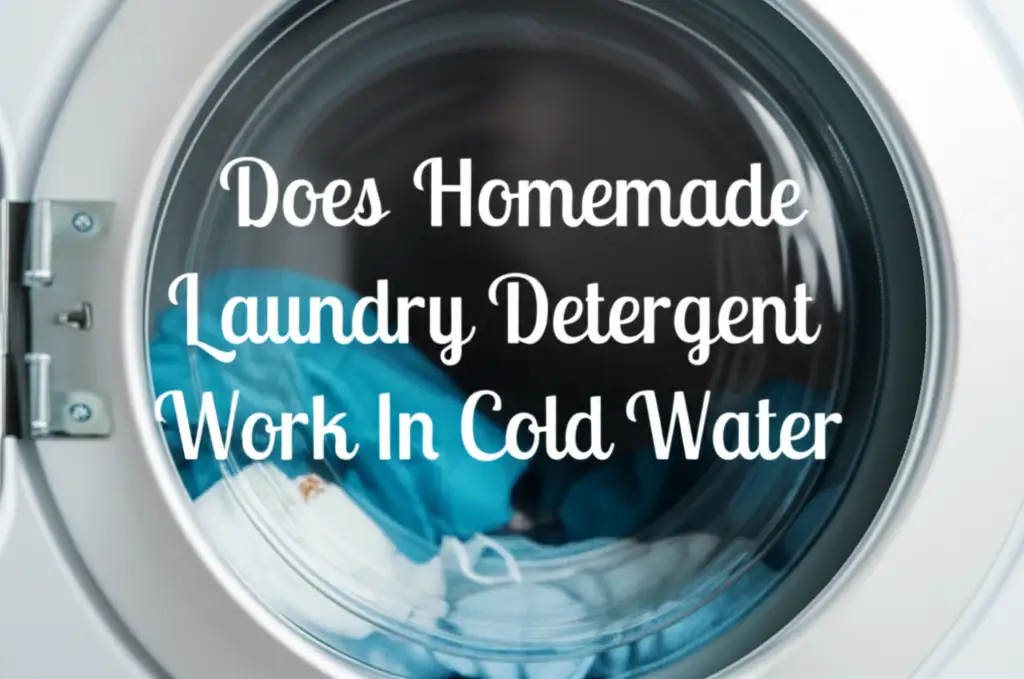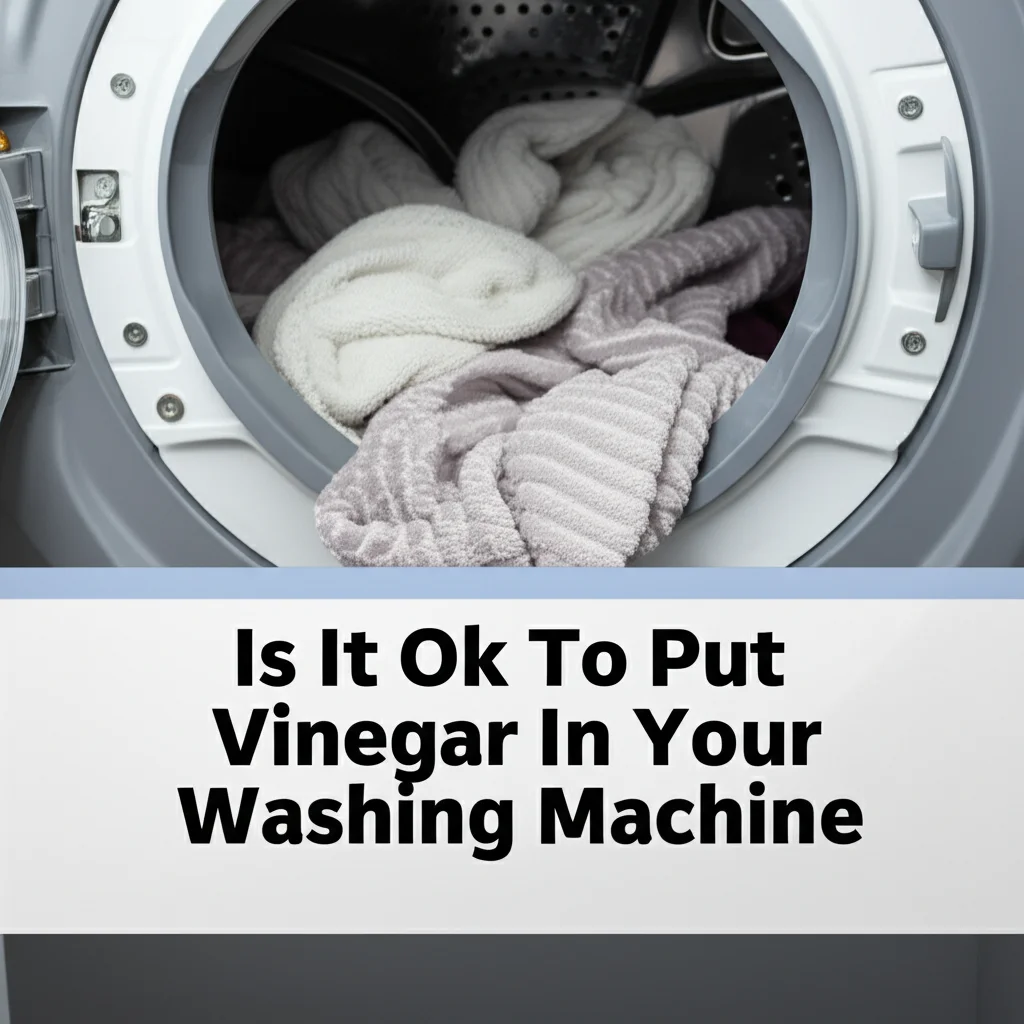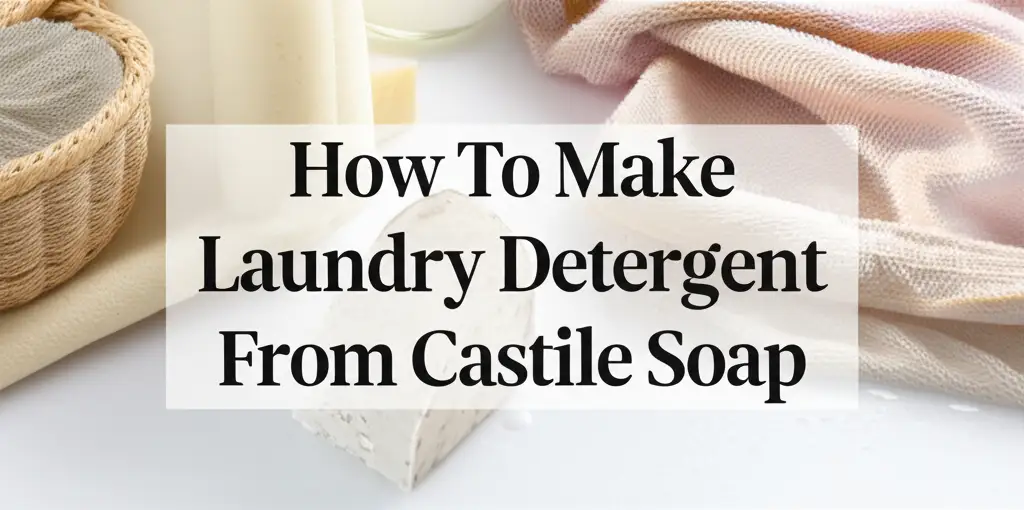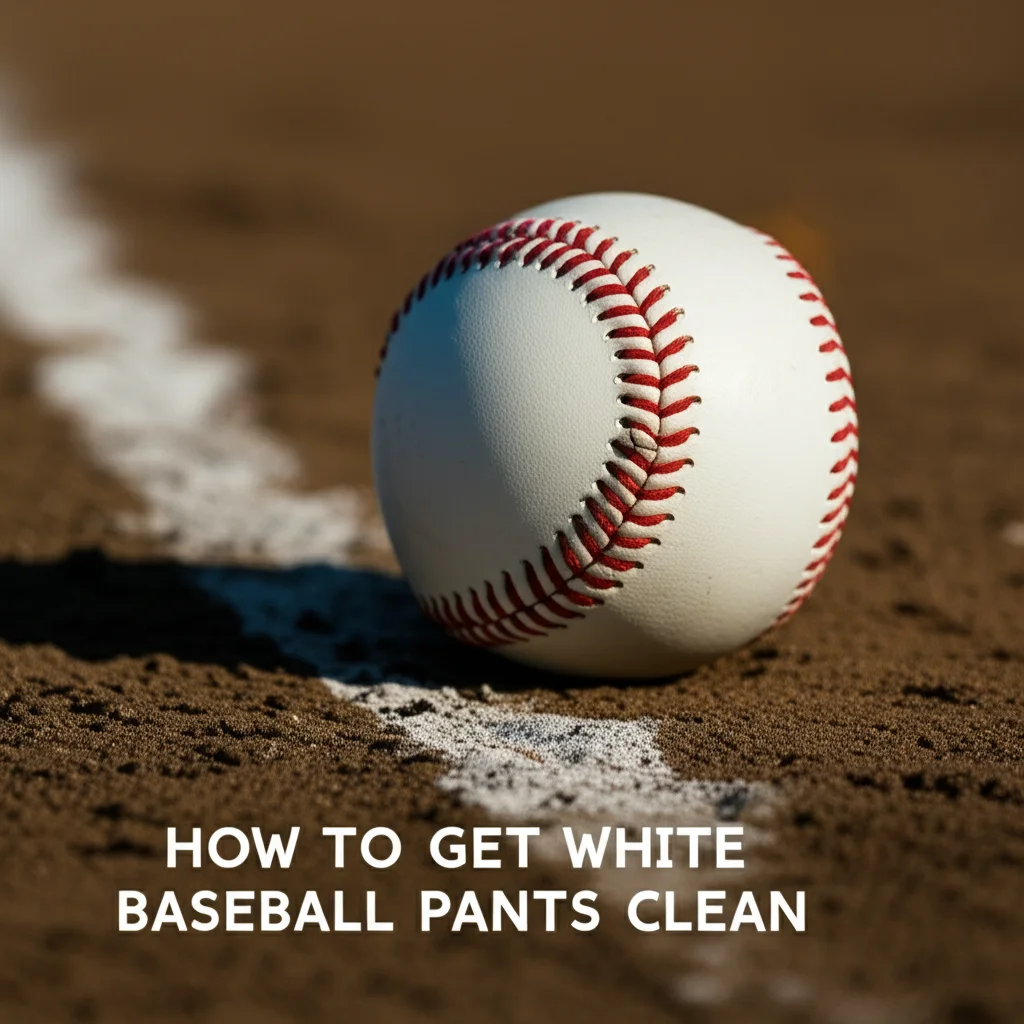· Katria Melrose · Laundry & Home Care · 23 min read
Does Homemade Laundry Detergent Work In Cold Water

Homemade Laundry Detergent in Cold Water: Does it Work?
Doing laundry does not have to be a hot affair. Many people wonder if they can effectively clean clothes using homemade laundry detergent in cold water. This question is important for those who want to save energy and protect fabrics. I know the feeling of wanting to simplify my routine and make eco-friendly choices. This article explains how homemade detergents perform in cooler temperatures.
We will explore the specific ingredients in homemade detergents. We will see how these ingredients react when water is cold. You will find practical tips for making your DIY detergent work well. We will also cover common problems and how to solve them. By the end, you will understand if homemade laundry detergent works in cold water and how to achieve the best results.
Takeaway
- Homemade detergents can work in cold water but require specific formulations.
- Key ingredients like grated soap and washing soda need to dissolve properly.
- Pre-dissolving ingredients improves cold water performance.
- Adjusting recipes and using proper techniques helps avoid residue.
- Cold water washing saves energy and extends clothing life.
Yes, homemade laundry detergent can work in cold water. Its effectiveness depends on the specific recipe and how you use it. Ingredients must dissolve well at lower temperatures. Proper formulation and application ensure clean clothes and prevent residue.
Understanding Cold Water Washing Benefits and Challenges
Washing clothes in cold water offers many benefits. It is good for your wallet and the planet. Cold water washing also protects your clothes. However, it presents unique challenges for detergents, especially homemade ones.
Why Choose Cold Water for Laundry?
Using cold water for laundry is a smart choice for several reasons. First, it saves energy. Heating water for laundry uses a lot of electricity or gas. Washing in cold water significantly reduces your household’s energy consumption. This leads to lower utility bills. I always look for ways to cut down on energy use, and cold water washing is a simple step.
Second, cold water helps clothes last longer. Hot water can cause fabrics to fade, shrink, or become damaged over time. Dyes bleed less in cold water. Delicate items like activewear and wool respond better to cooler temperatures. This keeps your clothes looking new for a longer time. I prefer my favorite shirts to keep their color and shape, so cold water is my go-to.
Third, it is better for the environment. Reduced energy consumption means fewer greenhouse gas emissions. Also, cold water helps prevent certain microfibers from breaking down as much. This keeps them out of our waterways. Choosing cold water washing is an easy way to support a more sustainable lifestyle.
Challenges for Detergents in Cold Water
Despite the benefits, cold water presents challenges for laundry detergents. The main issue is solubility. Many traditional detergent ingredients, both commercial and homemade, dissolve best in warm or hot water. When ingredients do not fully dissolve, they cannot clean effectively. They might also leave behind residue on clothes or in your washing machine.
Homemade detergents often contain ingredients like grated bar soap, washing soda, and borax. These ingredients can be harder to dissolve in cold water compared to the more refined chemicals in commercial detergents. Grated soap, for instance, might clump together. It needs friction and warmth to break down into smaller particles. If soap does not dissolve, it can stick to fabric. This leaves white streaks or a greasy feel.
Another challenge is stain removal. Some stains, especially greasy ones, respond better to warmer water. Cold water might not break down oils and fats as easily. This means your homemade detergent needs strong cleaning agents that work effectively without heat. You might need to pre-treat tough stains more often when using cold water. Understanding these challenges helps you adapt your homemade detergent recipe and washing methods for the best results.
The Science Behind Homemade Detergent in Cold Water
Homemade laundry detergents typically use a few basic ingredients. These include grated bar soap, washing soda, and borax. Each ingredient plays a specific role. Their effectiveness in cold water depends on how well they dissolve and interact at lower temperatures. Understanding this science helps you make a more effective homemade detergent for cold water use.
How Ingredients Dissolve and Clean
Grated Bar Soap: Bar soap provides the cleaning power. It contains fatty acids that lift dirt and grime from fabrics. In hot water, soap dissolves easily and creates suds. In cold water, however, soap can be slow to dissolve. This means it might not disperse evenly through the wash water. Undissolved soap can leave residue on clothes. It can also build up in your washing machine. For cold water, fine grating or using a liquid soap base helps with dissolution.
Washing Soda (Sodium Carbonate): Washing soda is a powerful cleaning booster. It helps soften water, allowing detergents to work more efficiently. It also boosts the pH of the water, which helps lift dirt. Washing soda dissolves reasonably well in cold water, but it needs time and agitation. When dissolved, it helps break down stains and neutralize odors. Its alkalinity is a key factor in cleaning performance.
Borax (Sodium Borate): Borax is another common ingredient in homemade detergents. It acts as a cleaning booster, stain remover, and odor neutralizer. It also helps soften water. Borax dissolves better in warm water than cold water. In cold water, it can sometimes settle at the bottom of the washer if not properly dissolved. Its mild alkalinity and ability to emulsify oils contribute to its cleaning power. Like washing soda, it enhances the overall effectiveness of the detergent.
Addressing Solubility and Residue
The biggest hurdle for homemade detergents in cold water is solubility. If the ingredients do not dissolve completely, they cannot clean effectively. They also leave behind a white, powdery, or waxy residue on clothes. This residue can make clothes feel stiff or look dingy. I once had a batch of towels come out with white streaks, and it was frustrating. Learning to manage solubility is key.
To improve solubility in cold water, consider these points:
- Finely Grate Soap: The smaller the soap particles, the quicker they dissolve. Use a fine grater or even a food processor for a very fine powder.
- Pre-Dissolve Ingredients: Before adding to the wash, mix your powdered homemade detergent with a cup or two of very hot water. Stir until everything dissolves. Then add this liquid mixture to your washing machine. This step significantly improves performance in cold water.
- Use Warm Water First (if possible): Some washing machines allow a short initial fill with warm water before switching to cold. This can help dissolve ingredients quickly.
- Liquid Homemade Detergent: Making a liquid version of homemade detergent often works better in cold water. The ingredients are already dissolved in water. This means they are ready to disperse immediately in the wash. You can learn more about making different types of homemade detergents, including liquid ones, by reading articles like How to Make Your Own Laundry Detergent That Smells Good.
By understanding how these basic ingredients behave, you can adjust your homemade detergent recipes. This will make them more suitable for cold water washing. It ensures your clothes come out clean and residue-free.
Crafting Your Cold Water Homemade Detergent Recipe
Creating a homemade laundry detergent that works well in cold water requires careful ingredient selection and preparation. The goal is to maximize dissolution and cleaning power without relying on hot water. I have tried several recipes, and some adjustments truly make a difference.
Essential Ingredients for Cold Water Use
The core ingredients for most homemade detergents are:
- Grated Bar Soap: Choose a natural, unscented bar soap. Fels-Naptha, Zote, or Kirk’s Castile are popular choices. For cold water, ensure the soap is grated extremely fine. The finer the particles, the faster they dissolve. Some people prefer to melt the soap first and then mix it with other ingredients to create a liquid concentrate.
- Washing Soda (Sodium Carbonate): This acts as a powerful cleaner and water softener. It helps lift dirt and boost the detergent’s effectiveness. Washing soda generally dissolves well, but agitation helps.
- Borax (Sodium Borate): Borax is a cleaning booster, stain remover, and odor neutralizer. It also helps soften hard water. While it prefers warm water, fine particles and good agitation allow it to work in cold.
Adjustments for Optimal Cold Water Performance
To make your homemade detergent shine in cold water, consider these adjustments:
Powdered Homemade Detergent (Modified):
- Ingredients:
- 1 bar (approx. 5.5 oz) natural bar soap, very finely grated
- 1 cup washing soda
- 1/2 cup borax
- Instructions:
- Grate the soap as finely as possible. Use a food processor if you have one. This creates a fine powder that dissolves faster.
- Mix the grated soap, washing soda, and borax thoroughly in a large container.
- Store in an airtight container.
- Usage for Cold Water: For each load, take 1-2 tablespoons of the mixture. Before adding to the washer, dissolve this amount in 1-2 cups of very hot water. Stir well until no clumps remain. Pour this dissolved mixture directly into the washer drum before adding clothes. This pre-dissolving step is critical for cold water success.
- Ingredients:
Liquid Homemade Detergent (Best for Cold Water):
- Ingredients:
- 1 bar (approx. 5.5 oz) natural bar soap, grated
- 1 cup washing soda
- 1/2 cup borax
- 1 gallon water (hot, for dissolving)
- Instructions:
- In a large pot, bring 4 cups of water to a boil. Reduce heat to low.
- Add the grated soap. Stir until it completely dissolves. This creates a thick liquid.
- Remove from heat.
- In a separate bucket or large container, combine the washing soda and borax. Add the remaining 12 cups (3 quarts) of hot water. Stir until these powders dissolve.
- Carefully pour the dissolved soap mixture into the washing soda/borax mixture. Stir well to combine.
- Let the mixture cool completely. It will thicken into a gel-like consistency. Stir it again before pouring into storage containers.
- Store in gallon jugs or old detergent bottles. Shake before each use, as it can separate.
- Usage for Cold Water: Use 1/4 to 1/2 cup per load, adding it directly to the detergent dispenser or drum. Since it is already liquid, it disperses easily in cold water. If you have an HE washer, remember that homemade detergents can produce more suds than commercial HE formulas. You can find more specific guidance on making natural detergents for HE washers in articles like How to Make Natural Laundry Detergent for HE Washers.
- Ingredients:
Choosing the right recipe and preparing your ingredients properly significantly impacts how well your homemade laundry detergent works in cold water. I have found the liquid version to be the most reliable for cold cycles.
Tips for Maximizing Homemade Detergent Effectiveness in Cold Water
Even with a well-formulated homemade detergent, certain practices enhance its performance in cold water. These tips ensure your clothes come out clean, fresh, and residue-free. I have learned these through trial and error, and they make a big difference.
Pre-Dissolving and Application
- Pre-Dissolve Powder: This is perhaps the most crucial step for powdered homemade detergents. Before adding your detergent to the washing machine, dissolve the recommended amount (usually 1-2 tablespoons) in a cup or two of very hot water. Stir until all the powder, especially the grated soap, is completely dissolved. Then, pour this liquid directly into the washer drum before adding your clothes. This ensures the cleaning agents are fully activated and dispersed from the start of the cycle, preventing undissolved particles from clumping or leaving residue.
- Add Directly to the Drum: For both pre-dissolved powder and liquid homemade detergents, adding them directly to the washer drum (before clothes for powder, or with clothes for liquid) is often better than using the dispenser. Dispensers can sometimes trap undissolved powder or thick liquid, especially in cold water. For specific instructions on where to put laundry detergent, you might find articles like Does Laundry Detergent Go In Before Or After Clothes helpful.
- Shake Liquid Detergent: If you are using a liquid homemade detergent, always shake the bottle well before each use. The ingredients can separate over time. Shaking ensures an even distribution of cleaning agents in every load.
Load Size and Water Levels
- Avoid Overloading: Do not pack your washing machine too full. Overloading prevents proper agitation, which is vital for detergent dissolution and cleaning, especially in cold water. Clothes need space to move freely to allow the detergent to reach all surfaces and lift dirt. A full load should still allow you to put your hand into the top of the drum and swirl it around easily.
- Adequate Water Level: Ensure your washer uses enough water for the load size. Some high-efficiency (HE) machines use very little water. This can be problematic for homemade detergents that need more water to dissolve and disperse. If you have an older top-loader, setting it to a higher water level can help. For HE machines, which often recommend special detergents like in How to Use Norwex Laundry Detergent in HE Machine, you might need to run a “rinse and spin” cycle afterward if you notice residue, or slightly reduce your detergent amount.
Pre-Treating Stains and Adjusting for Heavily Soiled Items
- Pre-Treat Stubborn Stains: Cold water is less effective at breaking down certain stains, especially oil-based ones. Always pre-treat stubborn spots before washing. Use a commercial stain remover or a paste made from washing soda and a little water. Apply it directly to the stain, let it sit for 15-30 minutes, then wash as usual. This gives your homemade detergent a head start.
- Soaking Heavily Soiled Clothes: For very dirty or smelly items, a pre-soak can work wonders. Fill a tub or basin with cold water and a small amount of your homemade detergent. Let the clothes soak for 30 minutes to a few hours before transferring them to the washing machine. This helps loosen dirt and odors before the main wash cycle.
- Adjust Detergent Amount: For very large loads or heavily soiled items, you might need to use slightly more homemade detergent. However, be cautious not to use too much, as this can lead to more residue. Start with the recommended amount and adjust slightly based on your results.
By implementing these practical tips, you can significantly improve the effectiveness of your homemade laundry detergent when washing in cold water. This helps you achieve clean, fresh laundry while enjoying the energy-saving and fabric-preserving benefits of cold water washing.
Addressing Common Concerns: Residue and Cleaning Power
When using homemade laundry detergent in cold water, two common concerns arise: residue on clothes and insufficient cleaning power. These issues are often linked to the ingredients not dissolving properly. However, with a few adjustments and techniques, you can overcome these challenges. I have dealt with both, and finding the right balance makes a huge difference.
Preventing and Removing Detergent Residue
Residue is a frequent complaint with homemade detergents, especially when using cold water. It appears as white streaks, a powdery film, or a sticky feel on clothes. This happens when the soap or other powdered ingredients do not fully dissolve and rinse away.
- Ensure Full Dissolution: As mentioned, pre-dissolving powdered homemade detergent in hot water before adding it to the wash is the most effective way to prevent residue. For liquid homemade detergents, shaking the bottle well before use ensures even distribution of ingredients.
- Use the Right Amount: Using too much detergent is a common cause of residue. Homemade detergents are often concentrated. Start with a small amount (1-2 tablespoons for powder, 1/4-1/2 cup for liquid) and adjust if needed. More detergent does not always mean cleaner clothes; it often means more residue.
- Adequate Rinsing: Ensure your washing machine completes a full rinse cycle. If you consistently see residue, you might consider adding an extra rinse cycle, if your machine has that option. This helps flush away any lingering detergent particles.
- Clean Your Washer: Residue can also build up in your washing machine over time. This buildup can transfer back to your clothes. Regularly cleaning your washing machine, especially the detergent dispenser and drum, helps prevent this. You can find detailed instructions on how to keep your machine clean in articles like How to Clean Laundry Machine.
- Remove Existing Residue: If you already have clothes with residue, re-wash them without any detergent, adding 1/2 cup of white vinegar to the fabric softener dispenser. The vinegar helps break down the soap residue. For stubborn stains or residue caused by undissolved detergent, you can also refer to tips like those in How to Get Laundry Detergent Stains Out of Clothes After Drying.
Enhancing Cleaning Power in Cold Water
Sometimes, clothes might not feel as clean as expected, especially when dealing with tough stains or odors in cold water. Homemade detergents generally lack the enzymes and strong surfactants found in many commercial detergents.
- Pre-Treat Stains Religiously: Cold water struggles with certain stains, like grease or oil. Always pre-treat these specific areas before washing. A dab of dish soap directly on the stain, or a paste of washing soda and water, can work wonders.
- Boosters for Tough Loads: For heavily soiled items or particularly smelly laundry, consider adding a boost to your wash.
- White Vinegar: Adding 1/2 cup of white vinegar to the fabric softener dispenser during the rinse cycle helps remove odors and softens clothes naturally. It also aids in preventing residue.
- Oxygen Bleach (e.g., OxiClean Free): For whites and colorfast items, a scoop of oxygen bleach can enhance cleaning and brightening in cold water. It is generally safe for colors and works by releasing oxygen to break down stains.
- Baking Soda: Adding 1/2 cup of baking soda directly to the wash drum with your clothes can help neutralize odors and boost cleaning power.
- Proper Storage: Ensure your homemade detergent is stored in an airtight container away from moisture. Moisture can cause powdered ingredients to clump, making them harder to dissolve in the wash.
- Consider Water Hardness: Hard water can reduce the effectiveness of any detergent, including homemade ones. If you have very hard water, you might need to use a bit more washing soda or borax in your recipe. These ingredients help soften the water, allowing the soap to work more efficiently.
By proactively addressing potential issues like residue and focusing on enhancing cleaning power with boosters and proper techniques, you can ensure your homemade laundry detergent performs effectively, even in cold water.
Environmental and Cost Benefits of Cold Water DIY Laundry
Choosing homemade laundry detergent and washing in cold water offers significant advantages beyond just clean clothes. These benefits extend to your wallet and the environment, making it a truly smart choice for conscious consumers. I embraced this approach years ago, and the impact has been noticeable.
Saving Energy and Money
One of the most compelling reasons to wash in cold water with homemade detergent is the financial savings. I am always looking for ways to reduce household expenses, and laundry offers a great opportunity.
- Reduced Energy Bills: Heating water accounts for about 90% of the energy used by a washing machine. By consistently using cold water, you drastically cut down on electricity or gas consumption. Over a year, this translates into noticeable savings on your utility bills. It’s a simple change that adds up.
- Lower Detergent Costs: Homemade laundry detergent is incredibly inexpensive to make. The raw ingredients—bar soap, washing soda, and borax—are very affordable and can be purchased in bulk. Compared to buying commercial detergents, which can be pricey, especially those marketed for cold water, making your own can save you hundreds of dollars annually. I find it amazing how little it costs to keep my family’s clothes clean this way.
The combination of saving on energy and significantly reducing detergent costs makes cold water washing with homemade solutions an excellent strategy for budget-conscious households.
Eco-Friendly and Healthier Choices
Beyond financial benefits, this approach offers substantial environmental and health advantages.
- Reduced Carbon Footprint: Lower energy consumption means fewer greenhouse gas emissions. By choosing cold water washing, you directly contribute to reducing your carbon footprint. This supports efforts against climate change. Every little bit helps create a healthier planet for everyone.
- Fewer Chemicals in Waterways: Commercial detergents often contain phosphates, optical brighteners, and synthetic fragrances. These chemicals can be harmful to aquatic ecosystems once they enter waterways. Homemade detergents typically use simpler, more natural ingredients that break down more easily and are less damaging to the environment. I feel better knowing what goes down my drain is gentler on nature.
- Gentler on Skin and Respiratory Systems: Many people experience skin irritation or allergic reactions to the harsh chemicals and strong perfumes in commercial detergents. Homemade detergents, especially unscented versions, are often much gentler. They are a good choice for people with sensitive skin, allergies, or respiratory issues. This also means fewer synthetic chemicals circulating in your home environment.
- Less Plastic Waste: Making your own detergent also reduces plastic waste. You buy ingredients in larger boxes or bags and reuse your own containers for the finished product. This cuts down on the constant disposal of plastic detergent bottles. I love reducing my household’s plastic consumption wherever possible.
Embracing homemade laundry detergent and cold water washing is a powerful step towards a more sustainable and healthier lifestyle. It proves that effective cleaning does not require compromise on environmental responsibility or personal well-being.
Troubleshooting Homemade Detergent Issues in Cold Water
Even with the best intentions and recipes, you might encounter issues when using homemade laundry detergent in cold water. Common problems include clothes not smelling fresh, stubborn stains persisting, or visible residue. Do not get discouraged. Most issues have simple solutions. I have refined my routine by troubleshooting these common snags.
Dealing with Odors
Sometimes, clothes washed with homemade detergent in cold water might not smell as fresh as expected, or they might even retain faint musty odors.
- Ensure Thorough Rinse: The primary cause of lingering odors is often insufficient rinsing. Undissolved detergent or trapped dirt can lead to smells. Make sure your washer is set for a full rinse cycle. If your machine allows, add an “extra rinse” option.
- Add Odor Neutralizers:
- White Vinegar: Add 1/2 cup of white vinegar to the fabric softener dispenser at the start of the rinse cycle. Vinegar is a natural deodorizer and helps break down any residual odors and detergent.
- Baking Soda: For particularly smelly loads (like gym clothes), add 1/2 cup of baking soda directly into the wash drum along with your clothes. Baking soda absorbs odors during the wash cycle.
- Sun Drying: Whenever possible, hang clothes outdoors to dry in the sun. Sunlight is a natural sanitizer and deodorizer. It helps air out clothes and remove any remaining smells.
Tackling Stubborn Stains
Cold water is less effective at breaking down certain types of stains, especially grease, oil, and protein-based stains.
- Pre-Treat Always: For any visible stain, always pre-treat it before washing. You can use a commercial stain remover designed for cold water, or make a paste with washing soda and a small amount of water. Apply the paste directly to the stain, let it sit for 15-30 minutes, then wash.
- Enzymatic Cleaners for Tough Stains: Homemade detergents lack the enzymes found in commercial cleaners that break down complex stains like blood, grass, or food. For these, consider using a separate enzymatic pre-treater or a commercial stain remover before the cold wash.
- Soak if Needed: For heavily soiled items or old, set-in stains, a pre-soak can be beneficial. Soak the garment in a bucket of cold water with a little washing soda or oxygen bleach for a few hours before washing.
Resolving Residue Issues
Residue is usually soap not dissolving or rinsing properly. It leaves white streaks or a stiff feel on fabrics.
- Pre-Dissolve Detergent: This is the most crucial step. Never add powdered homemade detergent directly to the wash in cold water without pre-dissolving it in hot water first.
- Reduce Detergent Amount: You might be using too much. Start with a smaller amount (e.g., 1 tablespoon for powder, 1/4 cup for liquid) and see if the residue disappears. Increase slightly only if cleaning power is insufficient.
- Clean Your Washer: Residue can build up in your washing machine itself. This buildup then transfers to your clothes. Regularly clean your washing machine. Pay attention to the detergent dispenser and the drum. A simple wash cycle with hot water and white vinegar or baking soda can help.
- Hard Water Considerations: If you live in an area with very hard water, minerals can react with soap to form soap scum, contributing to residue. Washing soda helps soften water. You might need to increase the amount of washing soda in your recipe slightly or use a commercial water softener additive.
- Check Machine Type: High-efficiency (HE) machines use very little water. This can make it harder for homemade detergents to dissolve and rinse. If you have an HE machine, ensure your homemade detergent is finely processed (for powder) or liquid. Consider using an “extra rinse” cycle.
By systematically addressing these issues, you can fine-tune your homemade detergent use in cold water. This helps achieve consistently clean, fresh, and residue-free laundry.
FAQ Section
Q: Can I use homemade laundry detergent in an HE washing machine with cold water? A: Yes, you can. However, HE machines use very little water, so it is crucial for homemade detergent ingredients to dissolve completely. Liquid homemade detergent works best in HE machines. If using powder, ensure it is super-finely grated and pre-dissolved in hot water before adding. Use smaller amounts to avoid excess suds and residue, as homemade detergents often produce more suds than commercial HE formulas.
Q: Will homemade laundry detergent truly clean my clothes in cold water? A: Yes, it can effectively clean clothes in cold water. The cleaning power comes from the soap, which lifts dirt, and washing soda/borax, which boost pH and soften water. For optimal results, pre-treat stains, pre-dissolve powdered ingredients, and use the correct amount of detergent. Heavily soiled items might require more attention or a pre-soak.
Q: Why do my clothes have white streaks after using homemade detergent in cold water? A: White streaks are typically caused by undissolved soap or other powdered ingredients leaving residue on fabrics. This happens more often in cold water because ingredients dissolve less readily. To prevent this, always pre-dissolve your powdered homemade detergent in hot water before adding it to the wash. Also, ensure you are not using too much detergent and your washing machine is not overloaded.
Q: How much homemade detergent should I use for a cold water wash? A: Start with a small amount. For powdered homemade detergent, 1-2 tablespoons is usually sufficient for a regular load. For liquid homemade detergent, 1/4 to 1/2 cup is a good starting point. Adjust the amount based on your water hardness, load size, and how dirty your clothes are. Less is often more, especially to avoid residue.
Q: Can I add essential oils to my homemade cold water detergent for scent? A: Yes, you can add essential oils for scent. Add about 10-20 drops per batch of dry ingredients or per gallon of liquid detergent. Essential oils do not affect cleaning power. They simply provide a natural fragrance. Add them to the finished product for the best scent retention.
Q: Is homemade laundry detergent safe for all fabric types in cold water? A: Homemade detergent is generally safe for most fabric types. However, some delicate materials like silk or wool might respond better to specialized gentle cleaners. The alkalinity from washing soda and borax can sometimes be harsh on these specific fibers over time. For everyday laundry and synthetics, homemade cold water detergent is usually fine.
Conclusion
Using homemade laundry detergent in cold water is a powerful way to clean clothes effectively while saving energy and money. My personal experience confirms that it works beautifully. It requires understanding how ingredients perform at lower temperatures. It also requires adopting best practices. The key is ensuring your soap and other cleaning agents dissolve completely. Pre-dissolving powdered formulas in hot water or opting for a liquid homemade detergent vastly improves performance in cold cycles.
By embracing cold water washing with your DIY detergent, you reduce your utility bills. You also extend the life of your clothes. Furthermore, you make an environmentally friendly choice by cutting down on energy consumption and chemical waste.





